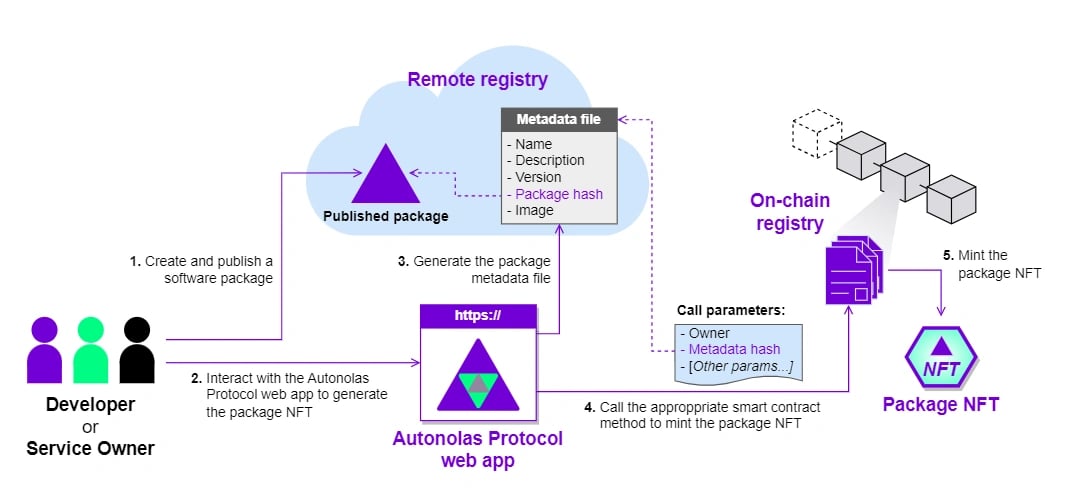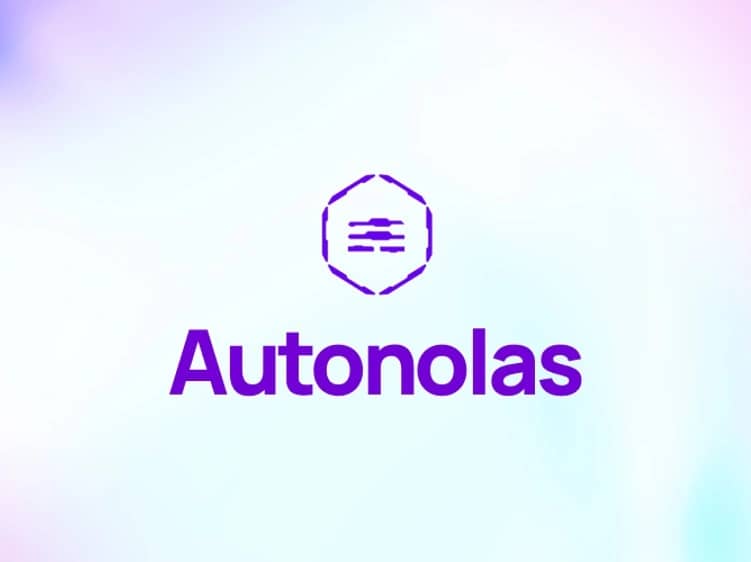Autonolas
Autonolas 是一个平台,致力于为开发者和去中心化自治组织 (DAO) 开发自主应用程序,通过其开源软件堆栈为持续运营、独立决策和外部交互提供基础。 [1]
概述
Autonolas 解决了区块链环境中自主应用程序(称为链下服务)的基本需求。该平台提供了一个开源软件堆栈和一个链上协议,从而促进安全运营并激励自主应用程序的开发。Autonolas 技术堆栈包含四个关键构建块,从而实现全栈自主性并为应用程序增长创造机会。Autonolas 旨在将业务逻辑包含在其软件组件中,以便在加密货币领域中使用。[2][3]
架构
Autonolas的软件框架Open Autonomy构成了构建代理服务的基础,这些服务是作为多代理系统运行的链下自主实体。这些服务增强了链上功能,同时主要驻留在链下,从而可以创建新颖且完全自主的应用程序。 [4]
多智能体系统架构
Autonolas采用多智能体系统(MAS)作为构建自主软件服务的基石。MAS涉及在复杂、多方利益相关者场景中运行的软件智能体组,这些场景具有竞争激励,以下称为智能体服务。开放区域框架是由Autonolas联合创始人共同创建的加密货币友好型MAS框架,是实现Autonolas智能体服务的主要手段。这个基于Python的开源库使开发人员能够创建能够进行点对点通信、与区块链和智能合约直接交互以及通过可重用组件实现任意业务逻辑的智能体。 [5]

代理服务的共识
Open Autonomy框架内的代理服务作为多方利益相关者系统运作,需要就行动或计算输出达成集体协议。Autonolas引入了状态最小化的共识工具,这是一种安全机制,促进代理之间内部共识,而无需依赖传统的区块链。最初的实现采用Tendermint作为共识引擎,提供安全的拜占庭容错复制和确定性终结性。共识工具的选择有助于提高代理服务的效率和最小化信任,从而实现去中心化的容错操作。 [6]
Crypto-Native Agent Services 的架构
Autonolas 的链下代理服务在逻辑上是集中的,但跨多台机器复制,利用使用共识工具创建的临时区块链。该架构涉及控制代理和共识工具节点的运营商,这些节点相互连接以实现容错复制。每个代理运行一个 ABCI 应用程序实例,定义在临时区块链上复制的有限状态机。代理的 FSMBehaviour 确保主动逻辑,允许通过可重用组件和服务链以及 ABCI 应用程序的链接。[\ 7]
用于锚定自主服务的链上协议
链上协议是Autonolas的自主服务在目标结算层上的锚点,为服务创建、运营和安全提供基础。该协议采用模块化设计,具有可升级的模块和核心-外围架构,确保可扩展性而不影响安全性。Autonolas的链上协议支持多种角色,包括创建代理组件的开发者、控制服务的服务所有者、运营代理实例的运营商以及使用服务的用户。该协议依赖于ERC-721 NFTs来唯一表示代理组件、规范代理和服务,确保不变性和抗审查性。此外,该协议允许ABCI应用程序的链接和服务扩展合约的集成,从而在代理协议范围之外提供灵活性和定制性。[7]
Autonolas 协议
Autonolas 协议代表一套智能合约,旨在引导、保护和管理公共区块链中的软件代码。该协议采用开放自治框架作为实现自治服务的主要结构,并可适应其他框架。 [8]
部署和组件
Autonolas协议目前在以太坊 主网和Göerli测试网上运行,包含三个主要组件:[8]
- 链上注册表: 促进自治服务、软件代理和代理组件注册为链上NFT。此功能扩展到将组件组装成代理,将代理组装成自治服务,以及这些服务的安全运行。
- 代币经济学: 概述了使用OLAS代币作为协调机制的经济框架。该模型促进了资本和代码的配对,吸引了不断增长的价值以确保去中心化服务,并根据开发者的贡献给予奖励。
- 治理: 授权Autonolas DAO,一个去中心化自治组织,随着时间的推移指导和改进Autonolas协议。[8]
铸造软件包 NFT
Autonolas 协议提供了一个 Web 应用程序,用于将软件包铸造为 NFT。用户可以铸造三种类型:服务、代理和组件。该过程包括创建元数据文件,将其发布在远程 IPFS 注册表上,并与协议智能合约交互以进行链上铸造。 [9]
Minting 的要求
- 钱包地址(Metamask 或 Safe 合约)
- 在远程注册表上发布的包哈希
- 用于市场表示的 NFT 图像 URL

管理服务生命周期
Autonolas协议管理服务的生命周期:[10]
- 预注册: 铸造服务的初始阶段。
- 操作:更新或激活注册。
- 激活注册: 等待代理运营商注册实例。
- 操作:注册代理或终止服务。
- 完成注册: 所有代理槽都已填满,等待部署。
- 操作:部署或终止服务。
- 已部署: 具有已部署服务的运营状态。
- 操作:终止服务。
- 已终止绑定: 服务终止;等待注册代理的解绑。
- 操作:解绑。
代币经济学
Autonolas协议的代币经济学采用OLAS代币作为开发者激励和绑定机制。它包括质押模型和飞轮效应,以吸引捐款,实现可持续的生态系统发展。 [11]
OLAS 代币用途
- 治理参与
- 访问服务白名单
- 为流动性支持进行 Bonding
Tokenomics Web 应用程序提供了一个用户友好的界面,用于捐赠、申领开发者奖励、审查 bonding 计划和管理债券。用户可以参与经济模型,并为 Autonolas 生态系统的增长做出贡献。 [11]
工具包
SMPKit
SMPKit是一个工具包,旨在构建在流动性池上实施投资策略的服务。此功能可以来自APY预测服务等服务生成的输出,或来自加密货币恐惧与贪婪指数等外部指标。使用SMPKit的池管理服务根据投资策略执行交易,执行诸如维持最佳投资策略、因费用过高而避免交易或在流动性池之间执行资本互换以获得更好定位等操作。 [12]
MintKit
MintKit是一个用于构建具有铸造能力服务的工具包。值得注意的是,基于MintKit构建的El Collectooorr服务,通过铸造Art Blocks drops自动创建NFT系列。MintKit采用复杂的逻辑来确定参与铸造和投标价格。社区资助的系列具有独特的ERC-20代币,从而能够对系列管理进行集体决策。 [13]
CoordinationKit
CoordinationKit 促进了通过铸造不断发展的徽章来展示社区贡献的服务的创建。通过监控用户贡献和更新徽章,使用 CoordinationKit 构建的服务使用 Ceramic 流来自动跟踪和奖励贡献,展示了自定义影响评估器的多功能性。 [14]
MLKit
MLKit 能够构建具有自定义机器学习能力的服务。一个例子是 ML APY 预测 Oracle,它使用可配置的机器学习技术来预测流动性池的收益率。该工具包包括收集历史数据、优化、训练预测算法以及就预测步骤达成共识的代理。实时演示展示了对 Uniswap 和 SpookySwap 的预测。 [15]
OracleKit
OracleKit 专为向区块链提供数据流的服务而设计。价格预言机是 OracleKit 下的一个代理服务,它基于来自各种来源的观察结果来估计 比特币 的价格。代理共同计算一个确定性函数来聚合观察结果,从而就估计值达成共识。该服务通过多重签名合约进行保护,并在 Polygon 链上结算估计值。[16]
IEKit
Impact Evaluator Kit (IEKit) 是 CoordinationKit 的高级版本,它使用 Ceramic 流自动跟踪和奖励用户贡献。通过 Twitter 提及跟踪服务进行演示,IEKit 监控注册和贡献,并根据分数更新用户徽章。该工具包是模块化的,适用于各种自定义影响评估器。 [17]
GovKit
GovKit是一个工具包,用于构建自主的、人工智能驱动的代表,这些代表在以太坊和Solana网络上对链上治理提案进行投票。它将其功能扩展到以太坊网络上Snapshot的链下治理提案。 [18]
MechKit
MechKit 实现了 AI 机甲的创建,以及在 Gnosis 链上的服务,允许用户在链上发布 AI 任务请求并高效地接收结果。AI 机甲使用 xDAI 费用运行,提供了一种无忧、原生加密且无限可组合的解决方案。 [19]
KeeperKit
KeeperKit 是一个用于构建代理服务的工具包,这些服务以可靠、无需信任和经济高效的方式执行智能合约功能。 KeeperKit 在链下基础设施上运行,允许进行不受区块链存储限制的复杂计算,并且无需支付昂贵的链上交易费用。 该工具包使个人、应用程序或 DAO 能够以无需许可、安全和完全自动化的方式执行 DevOps 作业。 [20]
MessagingKit
MessagingKit 是一个用于构建基于开放代理通信网络的代理消息服务的工具包。 [21]
